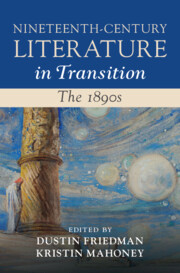Book contents
- Nineteenth-Century Literature in Transition: The 1890s
- Nineteenth-Century Literature in Transition
- Nineteenth-Century Literature in Transition: The 1890s
- Copyright page
- Contents
- Figures
- Contributors
- Acknowledgments
- Introduction
- Chapter 1 Race and Empire in the 1890s
- Chapter 2 Island Dandies, Transpacific Decadence, and the Politics of Style
- Chapter 3 The 1890s and East Asia: Toward a Critical Cosmopolitanism
- Chapter 4 Indulekha, or The Many Lives of Realism at the Fin de Siècle
- Chapter 5 Reading World Religions in the 1890s
- Chapter 6 Night Lights: The 1890s Nocturne
- Chapter 7 The Green 1890s:
- Chapter 8 “Only Nature Is a Thing Unreal”: The Anthropocene 1890s
- Chapter 9 Weird Ecologies and the Limits of Environmentalism
- Chapter 10 Queer Theories of the 1890s
- Chapter 11 Eugenics and Degeneration in Socialist-Feminist Novels of the Mid-1890s
- Chapter 12 The Conservative and Patriotic 1890s
- Chapter 13 Decadence and the Antitheatrical Prejudice
- Chapter 14 Religion and Science in the 1890s
- Chapter 15 Little Magazines and/in Media History
- Chapter 16 Fin-de-Siècle Visuality (and Textuality) and the Digital Sphere
- Index
Chapter 9 - Weird Ecologies and the Limits of Environmentalism
Published online by Cambridge University Press: 17 August 2023
- Nineteenth-Century Literature in Transition: The 1890s
- Nineteenth-Century Literature in Transition
- Nineteenth-Century Literature in Transition: The 1890s
- Copyright page
- Contents
- Figures
- Contributors
- Acknowledgments
- Introduction
- Chapter 1 Race and Empire in the 1890s
- Chapter 2 Island Dandies, Transpacific Decadence, and the Politics of Style
- Chapter 3 The 1890s and East Asia: Toward a Critical Cosmopolitanism
- Chapter 4 Indulekha, or The Many Lives of Realism at the Fin de Siècle
- Chapter 5 Reading World Religions in the 1890s
- Chapter 6 Night Lights: The 1890s Nocturne
- Chapter 7 The Green 1890s:
- Chapter 8 “Only Nature Is a Thing Unreal”: The Anthropocene 1890s
- Chapter 9 Weird Ecologies and the Limits of Environmentalism
- Chapter 10 Queer Theories of the 1890s
- Chapter 11 Eugenics and Degeneration in Socialist-Feminist Novels of the Mid-1890s
- Chapter 12 The Conservative and Patriotic 1890s
- Chapter 13 Decadence and the Antitheatrical Prejudice
- Chapter 14 Religion and Science in the 1890s
- Chapter 15 Little Magazines and/in Media History
- Chapter 16 Fin-de-Siècle Visuality (and Textuality) and the Digital Sphere
- Index
Summary
In the context of art and literature, the term "weird" refers to a sense of anxiety or terror regarding an ecological force seemingly acting on indeterminate motivations with little or no concern for people. A diversity of factors contributed to the 1890s flourish of the weird, including the growing economic investment in environmental policy, the rise of popular occulture, and the strong general interest in the biological, geological, meteorological, and astronomical sciences that were inspiring new notions of, among other subjects, the possibility of nonhuman consciousness. While not part of an overt environmentalist initiative, the weird nevertheless brings forward perspectives on animal, vegetal, and atmospheric ontology in which natural elements are subjects worthy of recognition and respect. The fin-de-siècle weird was driven not by the question of what protections or rights should be extended to nonhuman elements of the ecologies in which we participate, but rather, more disconcertingly for many, by considerations regarding what agency these other forces – many mysterious or yet unrecognized – enact and perhaps even assume for themselves.
- Type
- Chapter
- Information
- Nineteenth-Century Literature in Transition: The 1890s , pp. 187 - 207Publisher: Cambridge University PressPrint publication year: 2023



